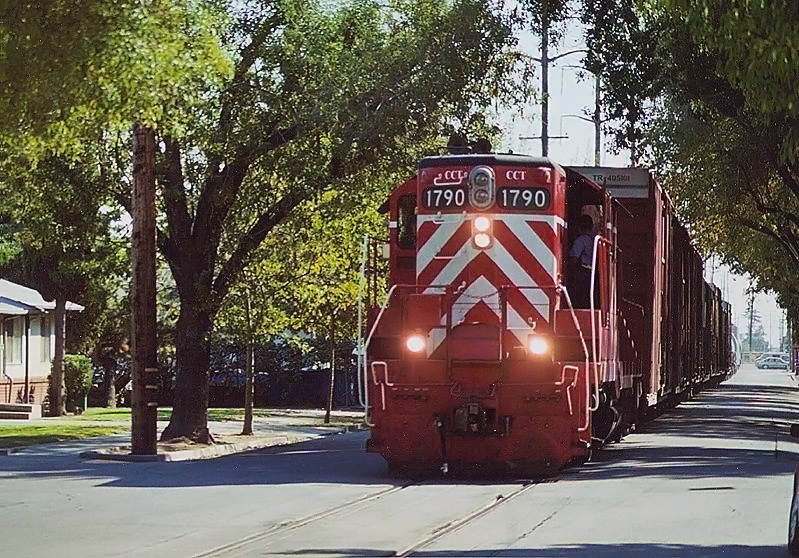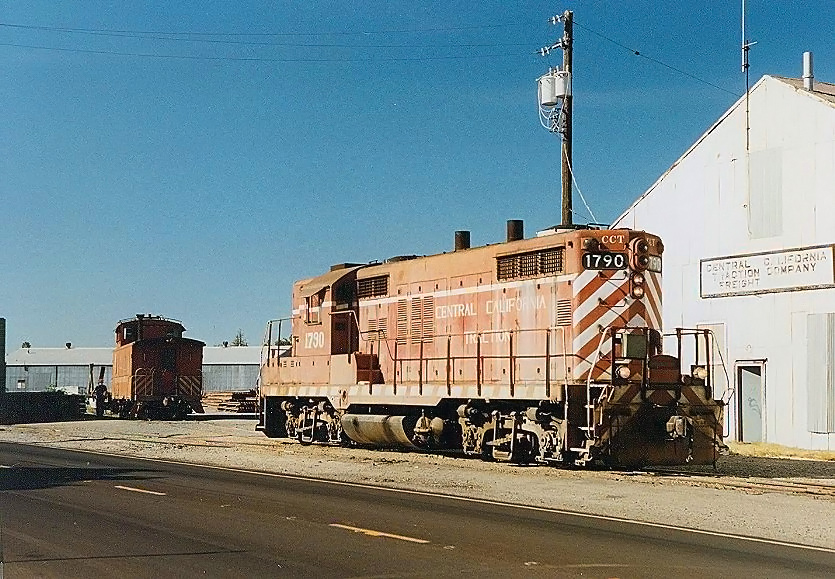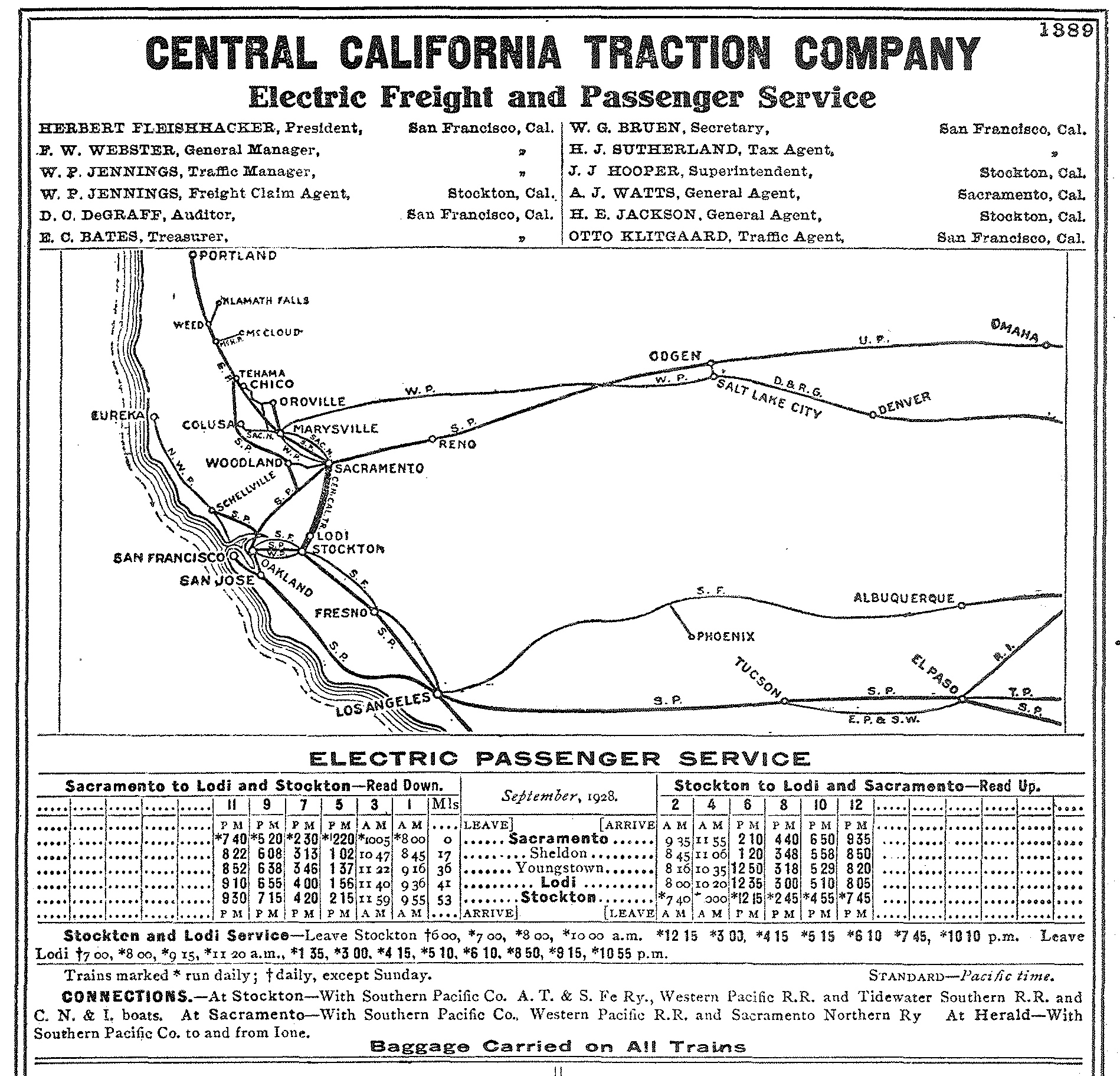Central California Traction Company: From Interurban To Short Line
Published: August 19, 2024
By: Adam Burns
The Central California Traction Company (CCT) is a notable short line with a rich history dating back to its 1905 incorporation. Headquartered in Stockton, California, the railroad originally linked Stockton, Lodi, and Sacramento via a 53 mile system.
While the network is currently still in place, the railroad only operates along the southern end today, maintaing two segments; the Central Valley Branch between Stockton and Lodi, as well between Milepot 14.0 (Guild) and a 1-mile industrial lead into Lodi.
Initially established to provide electric interurban passenger and freight services, the CCT transitioned to diesel power in the mid-20th century as passenger operations waned.
The move to dieselization was completed in 1946, after which the company focused exclusively on freight operations. Today, the CCT is jointly owned by BNSF and Union Pacific.
The railroad serves a diverse range of industries, providing essential transportation services for agricultural products, canned goods, beverages, and other commodities. Its strategic location in California's Central Valley, one of the most productive agricultural regions in the United States, ensures a steady demand for its services.
Additionally, the railroad supports local warehousing and distribution centers, enhancing the efficiency of logistics and supply chain operations in the area.
Overall, the CCT exemplifies the critical role of short lines in supporting regional economies and providing essential links within the national rail network. With its rich history and ongoing commitment to customer service and operational efficiency, the CCT continues to be a vital part of California's transportation landscape.
 Central California Traction GP18 #1790 has just left Mormon Yard and rumbles north down the middle of tree-lined B Street in Stockton on October 21, 2005. The train has two more blocks of street running to go. After returning to the shops on Cherokee Road the train will then head north to Lodi. Doug Kroll photo.
Central California Traction GP18 #1790 has just left Mormon Yard and rumbles north down the middle of tree-lined B Street in Stockton on October 21, 2005. The train has two more blocks of street running to go. After returning to the shops on Cherokee Road the train will then head north to Lodi. Doug Kroll photo.History
Established on August 7, 1905, the Central California Traction Company (CCT) was envisioned as an alternate streetcar line for Stockton's residents, standing in contrast to the Stockton Electric Railroad. Electrified passenger service began on September 1, 1907, ushering in direct competition with the Southern Pacific by connecting Stockton and Lodi.
By August 1910, CCT extended its reach to Sacramento, launching through passenger services and rapidly adding freight services. This bustling operation transported merchandise, livestock, and produce such as grapes, strawberries, and sugar beets, peaking at 36 daily passenger trains alongside vigorous freight activities.
CCT's interurban operations were innovative, employing overhead wires within the cities of Stockton, Lodi, and Sacramento, while intercity power was supplied by a covered third rail energized at an unprecedented 1200 volts DC—making CCT one of the pioneering users of high-tension DC power in the U.S. Within city limits the interurban utilized a 600-volt overhead catenary system.
A pivotal management shift occurred in 1928 when the owning family attempted to sell CCT outright to the Southern Pacific. This sparked a power struggle among the Western Pacific (WP), Santa Fe (AT&SF), and SP.
The Interstate Commerce Commission (ICC) finally resolved this battle in 1936 by mandating a shared ownership among the three railroads. The economic downturn during the conflict led to CCT's last interurban passenger service on February 4, 1933.
However, local streetcars continued to operate in Sacramento until National City Lines acquired the service in 1943. The era of electric streetcar service ultimately came to an end on December 22, 1946.
This coincided with CCT transitioning to diesel power, acquiring its first pair of GE 44-tonners in November, 1946. On December 24, 1947, CCT fully embraced dieselization, marking the end of its storied era of electric freight railroading.
System Map and Timetables (1928)
Later Years
The CCT maintained operations on the line connecting Lodi, Stockton, and Sacramento until 1966, when the Sacramento belt line was closed. Subsequently, CCT acquired SP trackage rights to reach Sacramento. That same year, tracks leading into Sacramento’s city center were removed. By 1998, service was suspended entirely, though the tracks between Stockton and Sacramento have been preserved for future use.
Diesel Roster
| Road Number | Model Type | Builder | Completion Date | Serial Number | Notes |
|---|---|---|---|---|---|
| 25 | 44-Tonner | GE | 12/1946 | 28339 | Acquired new. Sold to Stockton Terminal & Eastern (#25). |
| 26 | 44-Tonner | GE | 11/1946 | 28333 | Acquired new. Sold to Associated Metals Corporation (#26). |
| 30 | 70-Tonner | GE | 1/1947 | 28512 | Acquired new. |
| 31-32 | 70-Tonner | GE | 2/1947, 8/1947 | 29082-29083 | Acquired new. #31 sold to Associated Metals (#31). |
| 40-41 | S1 | Alco | 2/1942 | 68678-68679 | ex-Alameda Belt Line D-1 and D-2. Sold to Stockton, Terminal & Western (#40-41). |
| 42 | S1 | Alco | 12/1941 | 69610 | ex-Northern Pacific Terminal (#34). |
| 43 | S2 | Alco | 10/1949 | 77123 | Renumbered from 45. Built as AT&SF #2369. |
| 44 | GP7u | EMD | 11/1953 | 18885 | ex-Alameda Belt Line #44/#2144; exAT&SF GP7u #2144; built as AT&SF GP7 #2868. |
| 50 | S4 | Alco | 5/1951 | 78777 | ex-Western Pacific #563. Sold to Foster Farms. |
| 70 | GP7 | EMD | 4/1953 | 18418 | ex-Reading #618. Sold to Eureka Southern Railroad (#70). |
| 80 | RS1 | Alco | 11/1949 | 77844 | ex-Tidewater Southern #746; ex-UP #1218; ex-Spokane Internationl #1218; built as Sokane International #207. |
| 90 | GP7 | EMD | 8/1956 | 16906 | ex-Reading #607. Sold to Sierra Northern Railway (#47). |
| 700 | GP7 | EMD | 5/1953 | 18228 | ex-Harbor Belt Line #102; built as Pacific Harbor Line #102. |
| 1201-1202 | BLG12CG | Brookeville Locomotive Works | 11/2014-12/2014 | 9912, 9920 | Acquired new. |
| 1222 | SW1500 | EMD | 8/1972 | 4608-46087 | ex-SP #2677. |
| 1501 | SW1500 | EMD | 11/1971 | 4608-20 | Renumbered from 1178; ex-UP #1178; built as SP #2610. |
| 1502 | SW1500 | EMD | 11/1971 | 4608-16 | Renumbered from 1174; ex-UP #1174; built as SP #2606. |
| 1503 | SW1500 | EMD | 11/1971 | 4608-14 | Renumbered from 1172; ex-UP #1172; built as SP #2604. |
| 1504 | SW1500 | EMD | 2/1970 | 35803 | Renumbered from 1146; ex-UP #1146; built as SP #2567. |
| 1790 | GP18 | EMD | 2/1960 | 5683 | Built as Rock Island #1343. |
| 1795 | GP18 | EMD | 10/1961 | 26936 | Built as Rock Island 1359. Sold to Bruggere & Monson (#1795). |
| 2101 | BL20CG | Brookeville Locomotive Works | 2011 | 9232 | Rebuilt from Maine Central GP38 #259. BEMX's demonstrator unit and the only of its type ever built. |
 Central California Traction GP18 #1790 ducks into the shop area to pick up caboose #24, then make up its train and proceed north to Lodi on October 21, 1996. Doug Kroll photo.
Central California Traction GP18 #1790 ducks into the shop area to pick up caboose #24, then make up its train and proceed north to Lodi on October 21, 1996. Doug Kroll photo.Today
Today, CCT runs three main operations. One operation is centered at the former CCT shops on Cherokee Road in Stockton, utilizing #44, a chop-nose former Alameda Belt Line/former Santa Fe GP7u, alongside a recently rebuilt and repainted GP18 (#1790). This crew operates five days a week between Stockton and Lodi, a schedule bolstered by new customer demand.
The second and third crews operate from the Port of Stockton, where CCT also has its main offices. This team runs six days a week, employing four ex-SP SW1500s.
All four have been repainted in a refreshed version of CCT’s iconic red and white livery. Additionally, the railroad now operates a low emissions variant, a BL20CG numbered 2101.
Recent Articles
-
New Jersey's 'Wine Tasting' Train Rides
Dec 13, 25 11:26 PM
If you're seeking a unique outing or a memorable way to celebrate a special occasion, wine tasting train rides in New Jersey offer an experience unlike any other. -
New Hampshire's 'Wine Tasting' Train Rides
Dec 13, 25 11:18 PM
This article details New Hampshire's most enchanting wine tasting trains, where every sip is paired with breathtaking views and a touch of adventure. -
New York - Murder Mystery - Dinner Train Rides
Dec 13, 25 10:30 AM
New York State, renowned for its vibrant cities and verdant countryside, offers a plethora of activities for locals and tourists alike, including murder mystery train rides!




